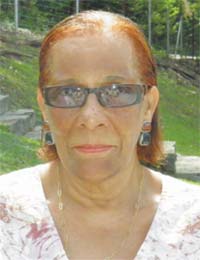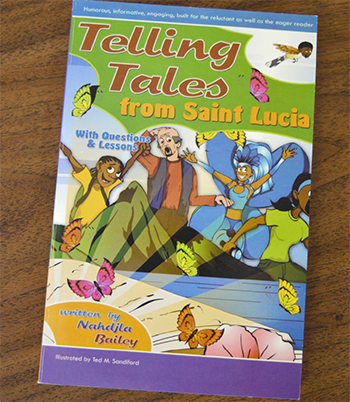
Dear Editor:
What with our Maria Islands and sacred whiptail lizard being so hugely in the news, I thought it might be interesting for ‘them as don’t know’ to painlessly acquire a smattering of information about the whiptail and its environment on Maria Major at the same time that they and the kiddies indulge in some fantasy (or alternative facts, if you like) with Wilbur Whiptail as he and his two young friends cross over to the mainland to have a day’s adventure in Vieux-Fort. The story comes from my book “Telling Tales from Saint Lucia”, pub. Caribbean Chapters, 2010. As it stands, the story is simply entitled “Wilbur Whiptail”, but I can’t help thinking that for a new edition I may have to alter its title to something like “What would Wilbur Say?” or “Wilbur Joins the Fray” and also perhaps to update its ending to read: Time now to make their way back to the jetty. How will they get across or – even more to the point, when? “Have you forgotten?” said Wilbur. “No big deal. We’ve got the new causeway now, remember?” – instead of its current version: Time now to make their way back to the jetty, How will they get across or – even more to the point, when? After all, they are a group of daring adventurers, and they’ll cross that bridge when they come to it!
It’s true what they say: Wilbur the whiptail is a snob, a great big snob. Perhaps the biggest snob in all mankind – or, should that be, lizardkind? He resides on the tiny island of Maria Major, just 1000 yards from the nearest point on the mainland and St Lucia’s second town, Vieux-Fort. Wilbur has every reason to be a very proud lizard, belonging as he does to a rare species found only on Maria Major and – get this – sporting the colours of the national flag of his country, St Lucia. That’s right! Adult males, like Wilbur, are white, yellow, black and blue. Now, this is no chicken and egg situation, I hope you can tell. Let’s be clear about that. For there is really no doubt whatsoever that Wilbur’s ancestors possessed their colours long, long, long before the national flag ever got its.
On this warm afternoon, Wilbur is sunning himself in an area full of cacti. He much prefers to linger in the cacti forests as they provide security from the birds of prey such as the American Kestrel, which just might be on the lookout for a good meal. Wilbur sure does not want to be the one to provide the hungry bird with a delicious meal! Our little reptile friend also enjoys being among the dry scrub and grasses on the other side of the island, where he can admire the Flambeau tree with its beautiful red blooms, but over there he feels much more open to attack.
Wilbur Whiptail is looking around him and thinking what a nice sunny day it has been. He soon spots his young friends, Winston and Wilma, in the distance. At least, he’s almost certain it’s them. And what might they be up to? The pair is active today because it has been a warm, sunny day, and now in the late afternoon they are spending their time basking in the remaining sunlight. No doubt, they have eaten quite heartily already, hurrying and scurrying along the ground, searching on as well as beneath the leaf litter for insects and other food items including lizards smaller than themselves.

As for Wilbur, he already had quite a variety to eat today. Before the sun got too hot, this morning, he searched the ground by digging around – everyone knows what expert diggers whiptails are – and with the usual flick of his tongue, caught some juicy insects. Then he noticed some bits of a flower and fruit lying about, and though he was not quite sure what plants they came from, dug in and found them to be absolutely delicious. A bit later, he happened to find some tiny fish and other tasty seafood which had washed up on the shore, and again he wasted no time in downing them. He was not stupid. He got his food wherever he found it. Once the day began to get hotter, Wilbur did what he and the other lizards always do: he burrowed underground and stayed there till the cooler part of the afternoon when he came out again to relax.
So, curious Wilbur continues to observe Winston and Wilma, and thinks: Those two seem to be spending a whole lot of time together these days. I wonder what’s going on. Could it be that they are falling in love? With that, he checks them out even more carefully. They are typical juveniles because they are both still fairly similar in colour, but once Winston reaches adulthood, he will experience a colour change. And old Wilbur starts to think back to his young days when he looked pretty much like those two young things. Now, however, he is just like the other adult males, of a very dark greyish brown colouring with a black pattern and some white dots, plus thin grey lines running from his neck all the way to the base of his tail, not to talk of his belly which is a bright yellow; the underside of his hind legs and entire tail are of a turquoise sea blue colour. A picture postcard if ever there was one!
You know what?says Wilbur aloud. As far as I am concerned, I’m not such a bad looking guy after all. In fact, I’m pretty happy with my looks. I mean, look over there, what do you see? I see some of those other types who share these 24 acres with us whiptails. In my opinion, they ain’t half as good-looking as we are. Take for instance the ordinary ground lizard – well there is just no comparison! Not even the bird inhabitants have anything on us. And as for the different kinds of geckos and the worm snake – forget them! They’re just p-l-a-i-n: plain.
I think I’ll go and call on my young friends over there. I sure hope I won’t be interrupting anything important, like love talk or kissing or anything like that, says Wilbur,and he quickly shoots across to Winston and Wilma. The youngsters are really pleased to see their old friend. It’s so nice to have a good pal among the older generation, especially since older lizards hate to mix with young ones. Normally, the other male lizards aggressively chase the young lizards away from their food, so if the young ones have any sense, they simply keep clear of adult lizards. If they don’t – well, they just may become part of their menu.
Wilbur asks his friends what they are up to, and they reply that they are just chatting about this and that. They also tell Wilbur that they are recalling many of the stories which he has told them over the two years since they have known him. They consider themselves very lucky to have him for a friend, and they want him to know that they have learnt a great deal from him.
Old Wilbur feels good that he is a useful friend. He knows that he always has interesting stories to tell and he knows too that when he gets started, he can’t stop. It’s just that sometimes he gets quite bored with the little island. Then again, sometimes he finds it extremely interesting, like when Don John, his friend, pays his monthly visit to check on the state of things.
Don John has pretty much been the only regular visitor to Maria Major for years, although a couple of years ago, they – whoever ‘they’ are – decided to start letting both locals and tourists visit the little island. That did not last long, however, because some thoughtless persons would throw their empty bottles on the ground and these would trap lizards and they would eventually die. Worst of all was the time a visitor decided to break the rules and smoke on the island. He dropped his cigarette butt and started a fire…just like that! Luckily, the tour guide, with the help of all the visitors, was able to get the flames under control from the start, and no great harm was done. But that was enough to have a strict law put in place which closed the island to visitors, whether local or foreign.
Of course, the law was never meant to include Wilbur’s friend, Don John, who is the Head of the Wild Life Office on the mainland. Don John normally visits alone but from time to time he may arrive with some Wild Life experts who are visiting from overseas and want to see the much–talked-about whiptail specie of St Lucia, one of the rarest in the whole wide world.
Now, Winston and Wilma beg Wilbur to tell them one of his many stories. Wilbur is in a really happy mood today and feeling rather relaxed. First, he tells them a story about a cat and a lizard. What is a cat?the youngsters want to know. Wilbur tries to explain. Next, he tells his friends a story about a mongoose and a manicou. Again, Winston and Wilma question him about those animals, which they have never seen or heard of. They are curious and want to find out how Wilbur knows all those stories and strange names which none of the other lizards ever mention.
Wilbur sees their questioning faces; a strange feeling comes over him and he decides that this is the day when he will share his long-held secret with his two young friends. They deserve to be educated, and he has a responsibility to teach them as many things as he can. After all, he won’t be around forever.
Wilbur tells the young pair that he was not born on Maria Major like the rest of the whiptails. He was born on the mainland and brought to the island by his friend, Don John. He must have been about four years old at the time, and that was about four-and-a-half years ago. And you know what that means, don’t you?he asks his friends, but not expecting an answer. It means that I do not have a whole lot of time left. I think you must know that we whiptails usually last about ten years.
Read part two in next
Saturday’s VOICE)






